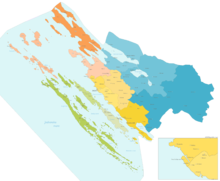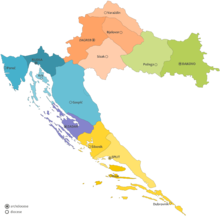Archdiocese of Zadar
|
Archdiocese of Zadar Archidioecesis Iadrensis Zadarska nadbiskupija |
|
|---|---|

Map of deaneries and parishes
|
|
| Location | |
| Country | |
| Metropolitan | Subjected directly to the Holy See |
| Statistics | |
| Area | 3,009 km2 (1,162 sq mi) |
| Population - Total - Catholics |
~164.310 ~151.215 (92.03%) |
| Parishes | 119 |
| Schools | 2 |
| Information | |
| Denomination | Roman Catholic |
| Sui iuris church | Latin Church |
| Rite | Roman Rite |
| Established | • 3rd century (Diocese) • 1154 (Archdiocese) • 1828 (Dalmatian Metropolitanate) • 1932 (Lost status of Metropolitanate; annexed to Šibenik) • 1948 (Archdiocese declared again) |
| Cathedral | Cathedral of St. Anastasia |
| Saint | Anastasia of Sirmium |
| Secular priests | 77 |
| Current leadership | |
| Pope | Francis |
| Metropolitan Archbishop | Želimir Puljić |
| Vicar General | Josip Lenkić |
| Map | |

Archdiocese of Zadar
|
|
| Website | |
| Website of the Archdiocese | |
The Roman Catholic Archdiocese of Zadar (Croatian: Zadarska nadbiskupija; Latin: Archidioecesis Iadrensis) is an archdiocese of the Latin Rite of the Roman Catholic church in Croatia. The diocese was established in the 3rd century AD and was made an archdiocese by the Pope Anastasius IV in 1154. Today, it is not part of any ecclesiastical province of Croatia but is only Croatian Archdiocese subjected directly to the Holy See.
Zadar (modern Croatia) has been a Roman Catholic diocese in Dalmatia since AD 381 and, since 1146, an archdiocese. Its succession of bishops numbers over eighty without noteworthy interruption. Bishop Sabinianus is mentioned in the "Register" of Gregory the Great. In one of his letters Pope John VIII names St. Donatus as patron of Jadera, Zadar's former name. Archaeologists find in Zadar many traces of ecclesiastical sculpture with German characteristics dating from the migration of the Germanic tribes. Zadar was the capital of Byzantine Dalmatia, but an example of Carolingian architecture is also found there, indicating that Zadar may once have belonged to the Franks and possibly explaining a visit of Bishop Donatus to Charlemagne in Dietenhofen.
...
Wikipedia
